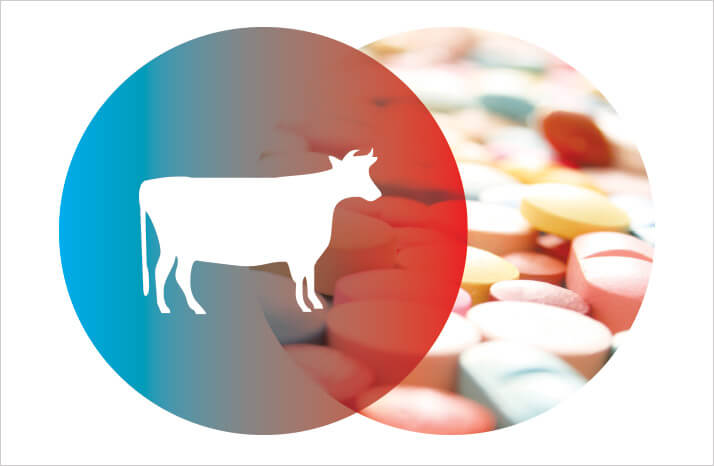After a two-year post doc in the pharmaceutical faculty of the University of Munich, Richard Stadler joined the Chemical Toxicology Group at the Nestlé Research Centre (NRC) in Lausanne in 1992. A spell in Singapore as senior quality technologist saw Richard return to the NRC in 1998, where he became head of the Biomarkers and Contaminants Group. Transferring to Switzerland in 2004, Richard now holds the position of Group Expert for Chemical Food Safety. He is active in several organizations and is also the editor of the Food Additives and Contaminants Journal.


The presence in food of antimicrobial residues at levels above legal limits is of major concern to manufacturers. It raises questions about the efficacy of controls along the food chain, introduces doubt as to the validity of the manufacturer’s food safety standards, and can lead to significant economic loss in the case of product withdrawal or, even worse, recall. More importantly, it can negatively affect the health of consumers.
The sheer variety of classes and the number of antimicrobial compounds that require attention presents a tough analytical challenge. They include many substances that are regulated and others that are banned in animal farming, such as chloramphenicol, nitrofurans and nitroimidazoles. Despite the fact that antimicrobials are strictly regulated in most developed countries, incidences of residue contamination in food are not uncommon, whether in violation of maximum residue limits (MRLs), or simply “detectable” in the case of banned drugs where no limits are set and the analytical method’s detection capability is decisive.
For further discussion of trends, see “Antimicrobial Trends and Risks”.
National control and enforcement laboratories frequently make use of inexpensive screening methods as a first check for drug residue compliance. Where indicated, these are followed up using confirmatory techniques, such as mass spectrometry (MS). Statutory screening programs require high throughput methods that are validated according to specific guidelines and predefined criteria, for example, as set out in the European Union’s 2010 Community Reference Laboratories Residues Guideline on the validation of screening methods. However, despite the guideline, the EU does not harmonize screening methods and the effectiveness of monitoring depends heavily on the methods used at any particular site. Traditional qualitative/semi-quantitative screening tests based on microbial inhibition are widely used. Several non-commercial kits, such as (a) EU Four Plate Test, (b) Nouws Test, (c) Calf Antibiotic and Sulfa Test (CAST), and a number of commercial kits, including (a) Premi Test, (b) Eclipse 50, (c) Charm Kidney Inhibition Swab (KIS), (d) Delvo SP NT, have been developed – and some fully validated – for performance in a variety of matrices, such as milk, meat, organs and fluids.
These broad-spectrum microbiological tests allow for multiclass detection and are cost-effective, but they should also meet certain performance criteria; specifically, their detection capability should be at or below the MRL with low false positive rates prior to employment in routine operation. Pikkemaat and colleagues compared the performance of three microbial growth-inhibition screening methods in routine testing in slaughter animals and concluded that there was a lack of sensitivity and high false positive rates for the EU Four Plate Test (on kidney) and Premi Test (on muscle), respectively. The Nouws Test showed adequate performance for tetracyclines below the MRL, but in kidney failed to detect a gentamicin MRL violation (1). Modifications to the kits protocol (solvent extraction) may improve the performance of microbial inhibitor tests in some cases (2). In dairy farming, upstream checks avoid bulk tanker rejection caused by a potential issue at a single farm. At the farm level, simplification of the test is crucial, as is speed and ease of operation. Essentially, a visual read-off with a “PASS or FAIL” decision (ideally close to or at MRL) within minutes is required. A diverse range of immuno and protein receptor tests designed for particular classes of antibiotics are now commercially available. For example, the BetaStar (a rapid lateral flow assay for the determination of beta-lactam residues in milk from Neogen Corp) has been optimized to achieve a result within two minutes (two incubation steps), which is ideal for conducting on-farm checks (3). However, recent developments in rapid tests are towards multiplexing, with technologies that can cover multiple classes of antibiotics. In fact, the development of rapid, higher performance methods that can detect several contaminants simultaneously is being addressed in the European seventh framework project CONffIDENCE (www.conffidence.eu). This initiative encompasses many different food matrices – seafood, fish feed, dairy products, meat, honey – and a broad selection of chemical contaminants, including antimicrobial classes, such as tetracyclines, sulphonamides, quinolones, coccidiostats, and banned drugs, such as chloramphenicol. Technology platforms range from simple lateral flow devices, flow cytometry, optical and electrochemical biosensors, up to more sophisticated “omics” approaches, such as ambient MS and near infrared. An important offshoot from this project is the development of test kits that enable the detection of multiple antimicrobials in a single strip at or close to the MRL. An example is the BEE4SENSOR (Unisensor, Belgium), a dipstick format test that enables the detection of tylosin, chloramphenicol, the main sulfonamides and (fluoro)-quinolones in honey. Similarly, the 4Sensor is a competitive antibody-based assay in a multiplex dipstick format for the detection of beta-lactams, tetracyclines, dihydrostreptomycin, streptomycin and chloramphenicol in milk in a single operation.
Many different multi-screening antibody-based kits are available in plate format but these require a reader and are therefore inconvenient for farm use. A further promising technology uses flow cytometric immunoassays with microspheres or beads functionalized by size, color, florescence or magnetism. Flow cytometry is far better suited to multiplexing than dipstick-based tests and, depending on the test format, up to 100 different assay combinations can be handled at high throughput (4, 5). The range of rapid test kits and screening approaches available today has increased speed and lowered costs but they do not provide full coverage of all antimicrobial residues of interest. Surveillance plans and programs must consider country-specific legislation and approval status, as well as typical antimicrobial use patterns in each geographic region, whilst not forgetting that banned compounds may still be in circulation.
Positive results in a qualitative or semi-quantitative rapid test kit or screening test need confirmatory analysis by a validated method. Over the past two decades, a plethora of chromatography–tandem mass spectrometry (LC-MS/MS) methods have been developed to detect and quantify residues of antimicrobials down to low parts per billion in all relevant food and feed matrices. Tandem MS instruments have become more affordable, their performance improves continuously and LC-MS is considered the technology of choice for targeted analysis of one or several classes of antimicrobials. To enhance speed and shorten tedious clean-up steps, techniques such as automated turbulent flow on-line LC-MS/MS look very promising, with reports of the successful analysis of 36 compounds from seven classes of antimicrobials in a single run for milk (6). To better anticipate risks, laboratories are now gradually shifting towards non-targeted screening tools in the analysis of veterinary drugs and growth-promoting agents. Several recent publications focus on the use of accurate-mass full-scan high-resolution (HR) MS, such as time of flight (ToF) and Fourier Transform Orbitrap MS. Table 1 illustrates some applications, both targeted and untargeted, covering a variety of compound classes and matrices.
Note: DART = direct analysis in real time, TFC = turbulent flow chromatography.
HRMS instruments show promise for antimicrobial screening in all relevant matrices, characterized by high throughput and fast data acquisition, and also have the potential to be used in quantitative analysis. The main challenge for HRMS is that higher resolving power may be required to achieve adequate sensitivity for the detection of banned compounds. A recent report comparing the performance of LC-MS/MS versus Orbitrap MS in the analysis of over 30 steroids showed that Orbitrap MS, operating at a resolution of 50,000 FWHM (full width at half maximum), compares well with LC-MS/MS in terms of selectivity and specificity, but showed somewhat inferior sensitivity for certain compounds (7).
Food globalization and increasingly complex supply chains exacerbate food safety and traceability risks – as exemplified by the recent horse meat scandal. The €15 m Agrifood GPS project (agrifoodgps.sharepoint.com), which began in January 2012 and runs until December 2016, is addressing untargeted screening in dairy, meat and fish products using HRMS with nuclear magnetic resonance (NMR) and Raman spectroscopy. In a recent paper, Ruiz-Aracama and colleagues from RIKILT applied untargeted metabolomics (NMR, UPLC-ToF/MS) to differentiate organic and conventional chicken feed (8). Such platforms, based on “omics” principles , allow for rapid profiling of foods and increased detection of “unknown” chemical contaminants. Coupled with well-developed spectral libraries, data processing software and bioinformatics tools, these new approaches will play a key role in our early warning system for potential food safety crises caused by unwitting incompetence or outright fraud.
- A. Martinez-Villalba et al., Rapid Communications in Mass Spectrometry 27, 467-475 (2013).
- M. M. Aguilera-Luiz et al., J. Agricultural and Food Chemistry, 61, 829-839 (2013).
- A. Kaufmann et al., Rapid Communications in Mass Spectrometry, 25, 979-92 (2011).
- A. Kaufmann et al., The Analyst, 136, 1898-909 (2011).
- N. Leon et al., J. Chromatography A, 1258, 55-65 (2012).
- E. van der Heeft et al., J. the American Society for Mass Spectrometry, 20, 451-463 (2009).
- R. Romero-Gonzalez et al., J. Chromatography A, 1218, 9353-65 (2011).
- D. Hurtaud-Pessel et al., Food Additives & Contaminants Part A, 28, 1340-51 (2011).
- R. J. Peters et al., J. Chromatography A, 1216, 8206-8216 (2009).
- G. Dervilly-Pinel et al., Analytica Chimica Acta, 700, 144-54 (2011).
References
- M. G. Pikkemaat et al., “ Screening methods for the detection of antibiotic residues in slaughter animals: comparision of the European Union Four-Plate Test, the Nouws Antibiotc Test and the PremiTest (applied to Muscle and Kidney)”, Food Additives and Contaminants, 28, 26-34 (2011). C. G. Magalhaes et al., “In house validation of PremiTest, a microbiological screening test with solvent extraction for the detection of antimicrobial residues in poultry muscles”, Food Additives and Contaminants, 29, 535 – 540 (2012). W. Reybroeck et al., “E. Validation of the beta-s.t.a.r. 1+1 for rapid screening of residues of beta-lactam antibiotics in milk”, Food Additives and Contaminants Part A, 27, 1084-1095 (2010). W. de Keizer et al., “Flow cytometric immunoassay for sulfonamides in raw milk”, Analytica Chimica Acta 620, 142-149 (2008). M. Zou et al., “Rapid determination of hazardous compounds in food based on a competitive fluorescence microsphere immunoassay”, Analytical Biochemistry 374, 318-324 (2008). K. Bousova, H. Senyuva, K. Mittendorf, K. “Multiresidue automated turbulent flow on line LC-MS/MS method for the detection of antibiotics in milk”, Food Additives & Contaminants Part A, 29, 1901-1912 (2012). L. Vanhaecke et al., “High resolution orbitrap mass spectrometry in comparison with tandem mass spectrometry for confirmation of anabolic steroids in meat”, Analytica Chimica Acta ,767, 118-127 (2013). A. Ruiz-Aracama et al., “Application of an untargeted metabolomics approach for the identification of compounds that may be responsible for observed differential effects in chickens fed organic and conventional diet”, Food Additives and Contaminants, 29, 323-332 (2012).




